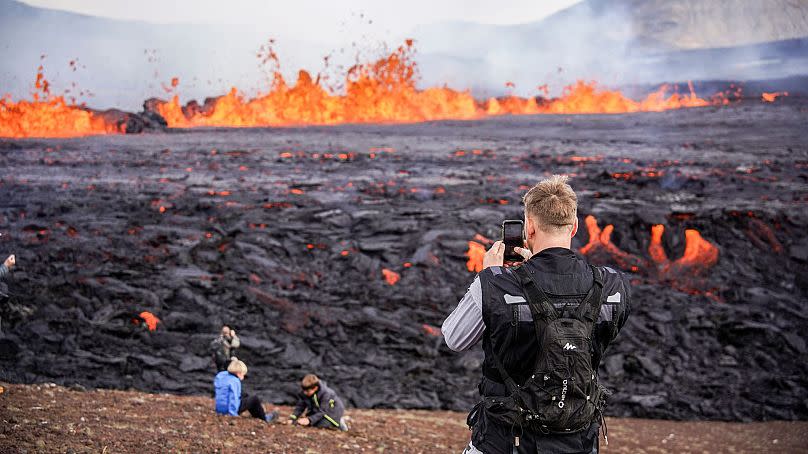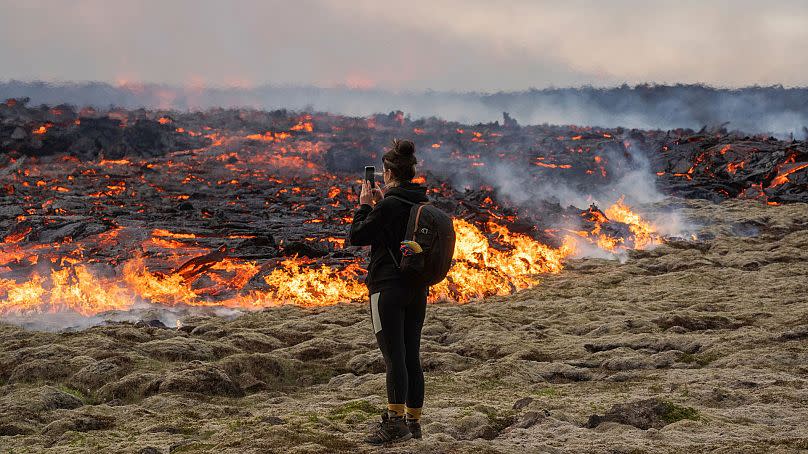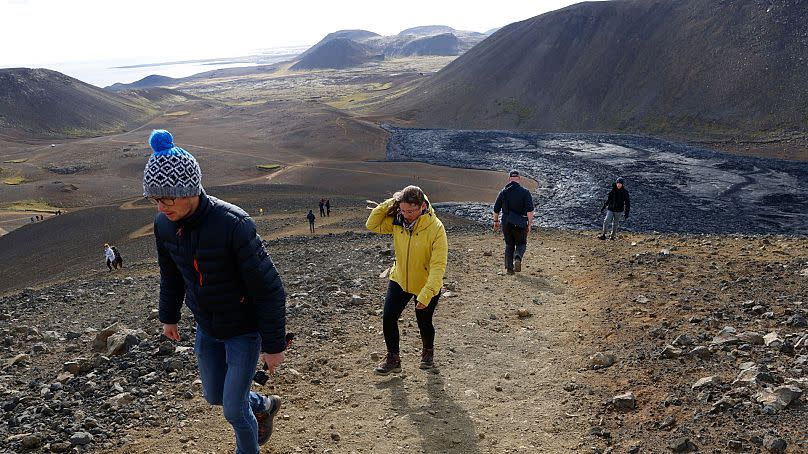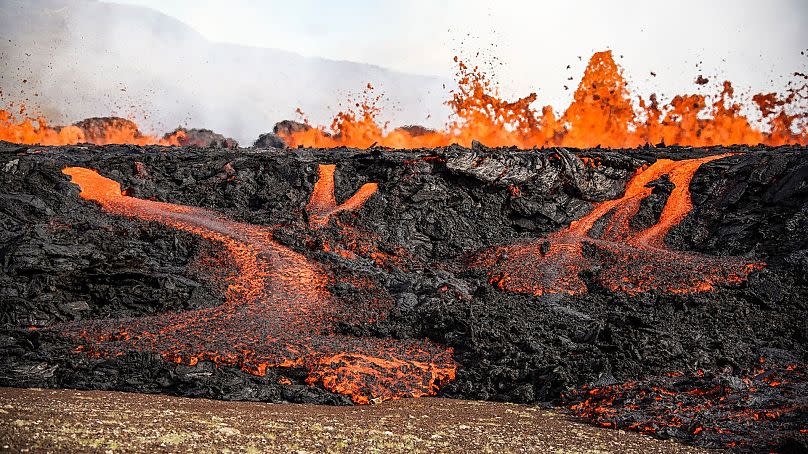Thirteen years after the Eyjafjallajökull volcano famously spewed ash into European skies, multiple eruptions across Iceland have spawned an unlikely new travel trend: volcano tourism.
Iceland is one of the most volcanically active places on Earth, with an eruption occurring approximately every three to five years, much to the delight of adventurers looking to catch a glimpse of mesmerizing lava flows.
The Nordic island is currently preparing for another localized eruption as officials warn a volcano near the Hagafell region could erupt at any time.
Thousands of tremors recently shook the Reykjanes Peninsula in the southwestern part of the country, and evacuation orders have been issued for the town of Grindavik.
But while Icelandic residents are on the run, specialist tour companies are busy answering questions about possible volcano visits.
The rise of volcano tourism in Iceland
In recent years, visitor interest in volcanic eruptions has increased dramatically, with the March 2021 eruption at Fagradalsjall attracting thousands of curious onlookers.
According to the Icelandic Tourism Board, more than 356,000 tourists visited the smoldering site while the eruption was underway.
Long lines often formed along the main hiking trails, and many visitors reportedly stayed near the lava field until the evening, waiting to take enviable nighttime photos of the fiery spectacle.
One of the IcelandThe most recent eruptions, Litli-Hrútur, generated enormous interest from locals and tourists as it spewed crimson lava and clouds of ash.
The spectacular eruption began on July 10, 2023, after increased seismic activity on the Reykjanes Peninsula – just 30 km southwest of Iceland’s capital Reykjavik.
Here, part of Fagradalsfjall mountain split open and began spewing plumes of molten lava and gas into the air, creating Litli-Hrútur – also called ‘Earth’s newest baby volcano’.
Once Icelandic authorities got the blazing fires under control, it became brand new volcano quickly became a unique natural attraction, with a path to the fascinating inferno.
“In light of the recent volcanic activitywe must emphasize that such events, due to the geological landscape of the country, are part of Icelandic life,” says Lína Petra Þórarinsdóttir, Head of Tourism in Iceland.
“All Icelandic infrastructure is planned and implemented with this in mind, and the Icelandic Met Office and teams of scientists are constantly monitoring all volcanic activity,” adds Þórarinsdóttir.

How to visit Iceland’s volcanoes safely
Icelandic authorities make it a priority to ensure safety and accessibility information is readily available, and the Reykjanes Peninsula eruption was no exception.
Þórarinsdóttir explains that tourists and Icelanders received regular updates about the eruption site and were urged to follow instructions and safety information.
Travel agents were keen to take advantage of the eruption and set up specialist volcano tours, with volcano hunters flying out within hours of the first volcanic activity.
Specialist tour operator Discover the World was one of the first to let travelers see it live volcano eruption at Fagradalsfjall earlier this year.
Just days after the eruption began northwest of the peninsula at Litli-Hrútur, the Iceland specialist waited for authorities to check the site and give the green light for their three-day investigation. volcano tour to offer.
“We are in close contact with the official authorities in Iceland to ensure we follow their guidelines, and we will only start organizing visits to see the eruption once it has been declared safe to visit,” said Georgina Hancock, marketing director from Discover the World.
“We ensure that our customers understand that the situation at the site will be continuously monitored and that we may need to make changes to their arrangements locally. However, safety will always be our top concern,” added Hancock.
Discover the World already has a loyal following volcano enthusiasts and launched the ‘Volcano Hotline’ in 1986 to offer the first ever Iceland trip to view a live eruption.
The unique lava hotline is still active to inform customers about possible trips to witness new eruptions in Iceland.


Is it safe to visit an active volcano?
However, traveling to an active volcano is not without risks and ethical questions. Chasing lava can be the thrill of a lifetime or a fatal mistake.
At least 1,143 people are estimated to have died in volcanic eruptions between 2010 and 2020. New Zealand’s popular tourist spot, the Whakaari volcano, suddenly erupted on December 9, 2019, killing 22 tourists and injuring 25 others.
“Safety depends on the circumstances, accessibility and species eruption,” says Magnús Tumi Gudmundsson, professor of geophysics at the University of Iceland.
“Most people visiting the recent eruption and previous eruptions over the past two years on the Reykjanes Peninsula go there on their own initiative, and the tours are not guided,” Gudmundsson added.
He also explains that although these eruptions produce lava, they are only mildly explosive and currents only occur at the vents.
“They are not really dangerous if you approach them with respect and keep a safe distance between yourself and the lava.”
“The danger to tourists hiking in Iceland it is mainly the weather and the possibility of getting lost and not finding the right way,” he adds.


What are the risks of visiting an active volcano?
Despite the flurry of glowing lava bursts on social media, not all eruptions in Iceland are tourist-friendly, and there are inherent dangers for visitors attempting to enter these volatile locations.
Eruptions often produce toxic gases SO2 (sulfur dioxide), which can cause lung damage.
Due to hazardous gases released during a massive Holuhraun eruption in Iceland in 2014-2015, a large area was closed to all traffic except for scientists and civil protection, who had the necessary protective equipment.
During the 2010 Eyjafjallajökull eruption, certain areas were as well forbidden for tourists because of the risk of flooding due to melting glacier water.
So, how can people visit eruptions? volcanoes in Iceland responsibly and safely?
“A system of organized, marked trails is critical,” says Gudmundsson, “so people don’t get lost.”
He explains that the recent eruptions on Reykjanes have released little magma and that gas emissions have not been at dangerous levels. This means that these volcanic sites are safe to visit to a certain extent.
Because Icelandic rangers and aid workers also check things out, visitors can book a specialized volcano tours or follow marked paths and tracks to witness the winding lava flows from a safe distance.
According to a 2021 studyManaging volcanic sites and opening them to spectators is possible thanks to strong cooperation between Icelandic scientific institutions and civil protection agencies.
The 2021 eruption of Fagradalsfjall provided an opportunity to fine-tune, test and validate hazard assessment models and improve the delivery of safety information to the public.
This collaboration ensured that no serious accidents or human deaths occurred during the most recent eruptions, allowing Iceland to continue to benefit from volcanic tourism.


Is it safe to travel to Iceland right now?
Despite the current seismic activity, flights continue to arrive and depart in Iceland as usual Foreign office does not advise against travel to Iceland, meaning holiday companies can operate as usual.
The current advice to British travelers from the FCO is: “Although there is no current eruption, it is increasingly possible that one may occur.” It adds that “Icelandic authorities continue to monitor the area closely.”
The message from the Icelandic Tourism Board is also resolute: “Iceland is very well prepared for volcanic events,” according to the website.
While the city of Grindavik and the world famous Blue Lagoon Stay closed, it’s business as usual in the Land of Fire and Ice, so grab your binoculars and hope you can witness an awe-inspiring eruption from a safe distance.